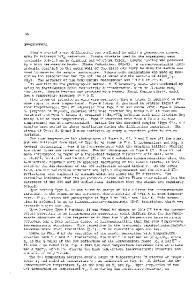Phase Transitions in Graphite Intercalation Compounds
- PDF / 2,606,221 Bytes
- 10 Pages / 415.8 x 637.2 pts Page_size
- 57 Downloads / 428 Views
PHASE TRANSITIONS IN GRAPHITE INTERCALATION COMPOUNDS R. CLARKE Department of Physics, The University of Michigan, Ann Arbor, Michigan 48109 USA ABSTRACT Graphite intercalation compounds offer a unique laboratory in which to study many kinds of phase transitions. These include melting, reorientations, staging, commensurate-incommensurate effects, and certain types of lattice gas transitions. Molecular and alkali-metal intercalates are discussed with reference to results of X-ray diffuse scattering studies as a function of temperature and pressure. INTRODUCTION Over the last few years graphite intercalation compounds (GIC's) have emerged as a very important class of materials in several respects. In addition to their technological promise in applications such as lightweight electrical conductors, GIC's are of much fundamental interest for the broad range of collective phenomena they display [1,21. Indeed, it is quite possible that GIC's variously exhibit every type of phase transition known to materials science. For this reason such compounds offer a unique and versatile "laboratory" in which to study the behavior of condensed matter under specific configurations which are otherwise difficult to realize experimentally. For example, rapid progress is presently being made in the theory of highly anisotropic systems and many specific predictions have been made which are in need of experimental testing. In this paper I will review some recent developments in the study of phase transitions in GIC's. The emphasis will be on structural effects as a function of temperature, pressure and intercalant composition. The layout of the paper follows a progression from the bulk, three-dimensional features of saturated GIC's to the more 2-d like behavior of the dilute compounds. Much of the work on the latter systems is quite controversial and not very well understood at present; it is as well to point out here that the current understanding of GIC's is largely limited by structural uncertainties, somewhat paralleling the difficulties traditionally encountered in disordered solids. For many purposes it is convenient to separate the discussion of structural behavior into two aspects: interlhayer effects arising from the stacking of host (carbon) and intercalant layers, and intralayer behavior, determined mainly by the in-plane arrangements of intercalant atoms or molecules. This division is motivated by the more or less anisotropic nature of these systems. However, it should be borne in mind that in-plane and interlayer effects are usually inextricably related in GIC's as we shall see. STAGING The most fascinating property of GIC's is "staging" or the formation of ordered sequences of host and intercalant layers. A sequence in which n host planes are interposed between every pair of intercalant layers is
Mat.
Res. Soc.
Symp. Proc.
Vol.
21
(1984)
Published by Elsevier Science Publishing Co.,
Inc.
624
referred to as a "stage n" compound. This provides an interesting mechanism by which to vary the physical anisotropy of the m
Data Loading...











